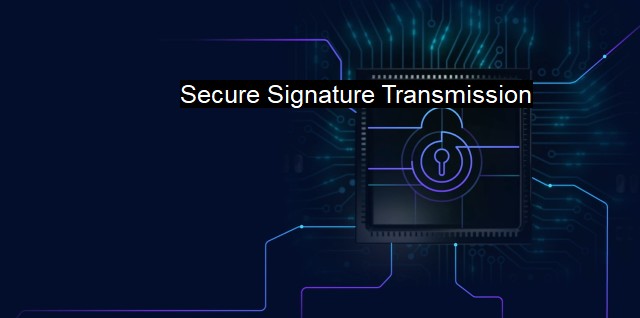What is Secure Signature Transmission?
Advancing Cybersecurity: Exploring Secure Signature Transmission for Safe and Reliable Signature Updates
Secure Signature Transmission (SST) is a cutting-edge concept with wide-reaching applications within the cybersecurity spectrum. Not a stand-alone instrument per se, but more an augmentation of an already collected arsenal of cyber defense technologies. Centered around the augmentation of antivirus (AV) functionality, one may understand this phrase as representing a method by which to transmit signature data between entities securely.To understand this innovative concept aptly, it is pivotal that we unwrap a couple of underlying thoughts that propel the construct. Fundamentally an offspring of security algorithms and signature-based wrestling techniques against viruses, SST finds ever-growing relevance in growing cybersecurity challenges.
Antivirus software fundamentally operates on an intricate wallpaper of cryptographic signatures. A summary of the countless numbering in viral strains that litter the cyber cosmos, these cryptographic signatures, will allow specified antivirus software to recognize, isolate, and eventually eliminate their viral counterparts. Herein lies the rationale for SST - ensuring the safe and harbor-free delivery of these antivirus programs.
Secure Signature Transmission aims to protect these 'keys' from interception or alteration while in transit. This is crucial given the numerous Advanced Persistent Threats (APTs) that specifically target the delivery of such patches or signatures from vendor to client. The compromising of an antivirus update - an unthinkable prospect seeking to weaponize the very tools intended for defense against such attacks.
Creating a secure channel of transmission is at the heart of SST. Whether through encryption, diversified routing, using clandestine techniques, or multi-factor authentication among others, SST ensures that antivirus programs reach their intended destinations without compromise. SST is not only limited to signature transport but also encompasses safeguarding updates and patches delivered by the host server.
By achieving a secure transmission, SST not only protects the individual files and packages transported but fortifies the cybersecurity infrastructure as a whole. Patches, when sent securely, protect not only the individual computer or Closed User Group (CUG) but defend the enterprise or body at large against existing vulnerabilities and fortify against potential threats. accurate and assimilative loading and unloading of these patches and updates into the system architecture too find place under the SST paradigm.
SST takes on amplified relevance when considering the harmful repercussions of a breach. Simply put, any cryptographic signature – the organizational master key if you will, prone to theft or alteration, leaves the door ajar for a multitude of cyber-attacks after signature validation. Quite like sheep in wolves' clothing, malware then might manipulate trusted pathways straight to the chosen targets, often with catastrophic consequences.
SST's essential and variable categories lie therein: communication security to protect from interception, authentication to ensure the data comes from a trusted source, and integrity, ensuring the data received is the data sent. Interception can be staved off by secure SSL/TLS channels, a staple across industries, and encryption. Authentication mechanisms, on the other hand, bolster confidence in sources of data and certificate systems. Data integrity takes form through buffer overflows and tests to ensure data sent equals data received.
In a world increasingly woven together by zeroes and ones, where digital breadths effortlessly span territorial buildings, the secure transmission of unequivocally significant data is paramount. Secure Signature Transmission, representing one such piece in this immense jigsaw puzzle, encapsulates an ethos of defense—standing guard over territorial integrity in patches and updates of Digital Realm. At its essence, SST is the security detail shadowing our files on the long road home, assuring we can rest safe in the knowledge that our guard has arrived, uncompromised, ready to take up arms against potential threats.

Secure Signature Transmission FAQs
What is secure signature transmission?
Secure signature transmission is the process of securely transmitting digital signatures over a network. Digital signatures are an important component of electronic transactions, and it is critical to ensure that they are transmitted securely to prevent tampering and unauthorized access.Why is secure signature transmission important for cybersecurity?
Secure signature transmission is important for cybersecurity because it helps to prevent fraud and ensures the integrity of electronic transactions. If digital signatures can be easily tampered with or intercepted, it could compromise the entire transaction and put sensitive information at risk.What are some best practices for ensuring secure signature transmission?
Some best practices for ensuring secure signature transmission include using strong encryption protocols, enforcing strong password policies, implementing two-factor authentication, and regularly monitoring and reviewing access logs. It is also important to use trusted antivirus software and keep it up-to-date to prevent malware and other cyber threats.Are there any specific tools or technologies that can help with secure signature transmission?
Yes, there are many tools and technologies available that can help with secure signature transmission, including digital signature software, secure document management systems, and secure email platforms. These tools use various encryption and authentication methods to ensure that digital signatures are transmitted securely and can be authenticated by the intended recipients.| | A | | | B | | | C | | | D | | | E | | | F | | | G | | | H | | | I | | | J | | | K | | | L | | | M | |
| | N | | | O | | | P | | | Q | | | R | | | S | | | T | | | U | | | V | | | W | | | X | | | Y | | | Z | |
| | 1 | | | 2 | | | 3 | | | 4 | | | 7 | | | 8 | | |||||||